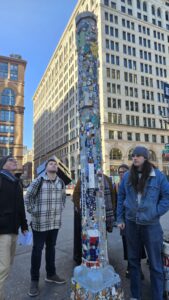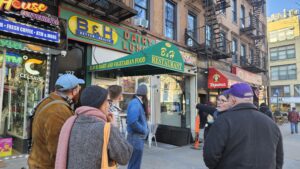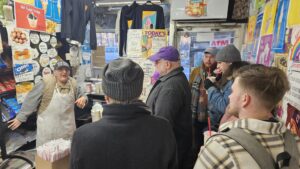The East Village: A Timeless Neighborhood

By Nicky Shapiro: Writer, tour guide, East Village resident. Make sure to check out the new East Village Food & History Experience that explores the people, stories, and cuisine that make this neighborhood so special.
WALK down Second Avenue with your eyes glazed to your phone and you’ll miss it. Get caught with your head down on Tenth Street and it’ll pass you by. Daydream amidst the pigeons on Avenue B and you won’t have a clue.
It’d be easy, amidst the endlessly shifting concrete ecosystem of New York City, to dismiss the East Village as just another casualty of the well-known vicious cycle of urban gentrification. In some ways, the neighborhood’s twentieth century history conforms to a familiar tale: an immigrant influx, dwindling government support, dystopian streetscapes (drug deals, burned out cars, corner holdups: the East Village had it all), cheap rent, an influx of artists taking advantage of said cheap rent, a brief but wistful period of creative explosion amidst bohemian paradise, and, finally, the ultimate death knell: wealthy outside investment which irrevocably renders the neighborhood unrecognizable.
It’s true that the East Village has undergone a vast transformation over the last half century. But dismissing the neighborhood on such grounds—lumping its trajectory alongside other former so-called bohemian Edens-turned shopping malls like SoHo and Williamsburg (a common practice)—ignores the endless local and original surprises the neighborhood still has to offer. Naysayers argue the East Village has lost its soul. But these nostalgists aren’t just clutching onto time which has passed them by; they are overlooking the many present-day miracles still hidden amidst the East Village and casually dismissing the myriad of ways which the neighborhood, despite the unthinkable rent and occasional eye-rolling chain store, has resisted the unceasing homogenization of New York City to carve out a particular niche as the beating heart of Downtown Manhattan. In a city which can so ruthlessly cast aside its history in favor of capitalizing on ephemerality, the East Village has managed to pull off the rarest of New York balancing acts: preserving its past while forging a distinctly modern identity. Drop into any East Village block and it’s unmistakable, instantly, where you are. The soul of the neighborhood is alive and well as ever.
The evidence is everywhere. All it takes to find it is a couple hours, an adventurous spirit, and a curious eye.
Keep your head glued to your screen, for example, and you’ll miss the flash of green and yellow extending over the sidewalk, the arched awning filled with a few characters in cursive script: B&H DAIRY. Wedged into a tiny storefront just south of St. Marks Place on Second Avenue, B&H might be the only restaurant you’ve ever heard of which describes itself as a “Dairy.” You’ll be able to order much more than fresh milk and cheese here; the name is a throwback to a different neighborhood, a time, in fact, before the name “East Village” even existed (the area was simply considered part of the Lower East Side until bohemian types began moving from the original “west” Village across the Bowery and calling their new home the “east” Village to sound more artsy in the mid-sixties). In 1937, the year B&H opened, the neighborhood was full of similar “Dairies,” restaurants so named because of the abundant Jewish influence on the neighborhood, the result of widespread Eastern European immigration to the Lower East Side in the late 19th and early 20th century. Because of both Kosher observation guidelines which ban the mixing of meat with dairy products and the unreliability of certified kosher meat in the early 20th century, a host of vegetarian restaurants which served fish and dairy-based items cropped up in the neighborhood by the 1930s. B&H’s Second Avenue location is extra significant as it lies in the shadow of what was once known as the “Yiddish Rialto,” a stretch of theaters which exclusively showed plays in Yiddish to cater to the local immigrant Jewish population through the middle of the century (later, from 1968 to 1971, the Fillmore East hosted legendary performances by artists like Led Zeppelin and Jimi Hendrix in a former Yiddish theater on Second Avenue and Sixth Street). The vast majority of the kosher-observant Jewish immigrants and all of the Yiddish Rialto theaters which once defined the block are long gone, but today B&H Dairy still stands, serving locals and canny tourists alike remnants of a bygone era: cheese pierogies, hot or cold borscht (depending on the season), and house-baked Challah French toast, all served fresh at a counter just as bustling with activity as it was over eighty years ago.

As an uninitiated observer, you might walk uptown a few blocks, cross over to Tenth Street, and get so caught up in the sidewalk cracks that you’d miss a simple sign protruding from an otherwise quintessential row of fire escape-crossed, five story apartment buildings: RUSSIAN AND TURKISH BATHS. The many passersby who assume the sign is a mere landmark, a throwback to a past era of Eastern European immigration, have clearly never ascended the stoop to have a peek inside. In operation since 1892, the Tenth Street Baths have provided East Villagers with the chance to partake in a tradition which stretches back at least as far as to Ancient Rome: spending the day at the local bathhouse. Indeed, the 133-year-old baths, replete with piping hot steam rooms, cold tubs, and “platza” treatments (featuring soapy oak leaf scrubbing), have served as a sanctuary for generations of “schvitzers” (Yiddish slang for someone taking a steam bath) looking to escape the hustle and bustle of the neighborhood. And just like the public baths of Pompeii, the Russian and Turkish Baths are indeed open to all. At various points during the 20th century, you could have found yourself draped in nothing but a towel next to John Belushi, Timothy Leary, or Frank Sinatra, all of whom were regular Tenth Street Baths frequenters. Perhaps most notably, the Italian Mafia was known for conducting operations inside, and to help their cause former owners reportedly hired deaf and mute masseuses who’d be incapable of spilling the beans were any trouble to arise with the mob (one mute masseuse continued to work at the baths until at least the mid-eighties). In the steamy shadow of this history, two Russian owners continue to manage the bathhouse out of the basement of the former tenement building, where today you’re just as likely to encounter a drenched, twentysomething model inside as you are a local taxi driver who’s owned her cab for half a century. Such is life at the Tenth Street Baths, where visitors of all shapes and sizes take plunges into the same icy pool, oblivious (or not) to the nearly century-and-a-half long cast of characters who preceded them.

Dry off, warm (or cool) down, and step back onto the street rejuvenated, paying special attention to avoid missing out on perhaps the greatest miracle the East Village has to offer. If you know anything about the neighborhood, you’ve likely heard of Tompkins Square Park, the former center of Kleindeutshland (Little Germany), filled with a history so checkered that if you refer to the “Tompkins Square Riot,” a local will turn back to you and ask, “Which one?” (the most notorious were both police-instigated, involving immigrant labor protests in 1874 and the forced removal of park squatters in 1988). The park is indeed glorious and unmissable, particularly in the spring and fall, but if you spent all your time in Tompkins Square you’d miss out on the dozens of smaller, distinct community gardens which dot the rest of the neighborhood, a kaleidoscope of green at a scale unmatched anywhere else in Manhattan. In the early 1970s, activists calling themselves “Green Guerillas” were fed up with the mounting number of neglected lots scattered across the Lower East Side. A small group of them, spearheaded by a young woman named Liz Christy, invented an ingenious solution: creating “seed bombs” to be tossed into vacant lots before a rain. From these humble origins, there is now hardly a block east of Avenue A in the East Village which isn’t home to a locally-operated, officially recognized public park. Some of these spaces, like the Sam & Sadie Koenig Garden on Seventh Street, are hardly the size of a small studio apartment. Others, including El Jardín del Paraíso and La Plaza Cultural, occupy large chunks of rectangular city blocks, and they serve as oases for East Villagers seeking refuge amidst plants and animals in the middle of Manhattan. Today the still-kicking Green Guerillas oversee volunteer efforts and publicly funded programs to encourage youth and residents of underserved communities to participate in activities ranging from gardening to poetry reading. Getting lost amidst this web of green space deep in the East Village is truly a treat, especially during warmer months, and is bound to elicit interesting and inspiring conversations with strangers at every turn.
The neighborhood is awash in opportunities to experience similar serendipity on any “ordinary” walk around the block. Marvel at the old tenement building painted like a vertical Puerto Rican flag long enough and you might catch the din of an amplified voice within—you’re standing in front of the Nuyorican Poets Café, a generative symbol of the flourishing Puerto Rican artistic movement which has shaped the neighborhood since a wave of post-WWII immigration brought thousands of new arrivals from the Caribbean island to the East Village. Catch a whiff of a devilish concoction known as a deep-fried Oreo outside Ray’s Candy Store on Avenue A, a tiny shop founded by an Iranian immigrant who worked as a dishwasher long enough to buy the storefront facing Tompkins Square Park and turn it into a soda fountain (and an occasional refuge during police riots of days past). Lean on a lamppost—literally—and rest your head against the awe-inspiring tiled mosaics of local artist Jim Powers, who pays homage to old landmarks (a list of bands who’s played the Fillmore East dotes the streetlight outside the side of the old theater) with colorful public art. Bite into the best veggie burger in the city at Superiority Burger, recently rated the second best new restaurant in New York, a new-age burger joint which manages to enliven the spirit of the legendary Ukrainian late-night diner Odessa, which preceded it. Refuse to believe your eyes inside Casey’s Rubber Stamps on 11th Street, where Irish immigrant John Casey has somehow maintained a viable business into the 21st century selling custom-made rubber stamps and inkpads for nearly four decades. Pop into a $10 yoga class at St. Marks Yoga, perhaps the only yoga studio in the world which is occasionally interrupted by the belly-splitting laughs emerging from the standup comedy club a floor below (and which resides in the same building as the former German Shooting Club, just a few doors down from the former office of Leon Trotsky, who, a few months before returning to Russia to join the October Revolution, edited a publication on St. Marks Place).

We often conflate timelessness with permanence, history with an obsession over preserving streetscapes and buildings and neighborhoods to appear exactly as they did, to the windowsill, upon conception. The East Village refuses, has always refused, to follow in this tradition. Today’s sweeping constellation of distinctly East Village institutions aren’t just relics, hands-off museums forever preserved in formaldehyde, locked away behind thick glass. They are living landmarks, odes not just to history but to function, and they continue to evolve with the ever-shifting neighborhood, unapologetically preserving authenticity while simultaneously adapting to modern New York realities. The East Village is filled to the brim with such gems, spaces which thrive today not because of an unrelenting pledge to ritual but because of their willing integration of past and present, the seamless welding of tradition and trend.
The last hundred years of East Village history reveals a series of generational usurpations; Germans, Eastern European Jews, beatniks, hippies, punk rockers, artists, college students, hipsters. Each group has left its distinct mark on the neighborhood, yet none can claim to be its defining steward. Instead, the East Village’s superpower is, and I suspect always will be, its uncanny ability to absorb and integrate each of its histories into an inexplicably cohesive whole, willingly harnessing past and present to generate fresh institutions unseen anywhere else in the world. Inside a nearly ninety-year-old Jewish hole-in-the-wall dairy, the restaurant’s Polish Orthodox Christian owner shouts out an order for a tuna melt in Spanish across the counter to a cook distracted by a conversation with an NYU philosophy major. Down the street from Trotsky’s former office, a tattooed yogi reclines into her Shavasana at the most affordable yoga studio in Manhattan in the same room just-arrived German immigrants once used as a shooting range. Unaware that the fifty-year-old candy shop he’s standing inside once sheltered scrambling victims of a 1988 police riot, a slim teenaged skateboarder waits for an egg cream and chats up the store’s ninety-year-old owner, hoping to secure an exclusive invite to his top-secret, invitation-only birthday party in the shadow of Tompkins Square Park next month.
That is timeless. East Village style.
Nicky Shapiro is a freelance writer and tour guide for Manhattan Walking Tour. You can read more of his original essays, commentary, and fiction on his website nickyshapiro.com.

